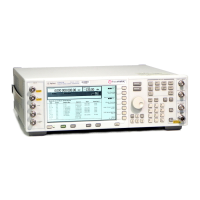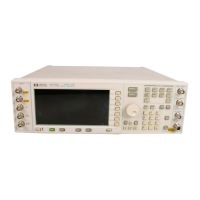Chapter 14 395
Real Time TDMA Formats
Enhanced Observed Time Difference (E-OTD)
GPIB commands to set up the ESG.
//Select Frequency band, channel, and power.
:FREQuency:CHANnels:BAND BPGSm
:FREQuency:CHANnels:NUMBer 40
:FREQuency:CHANnels:STATe ON
:POWer:LEVel:IMMediate:AMPLitude -10DBM
:OUTPut ON
//Select external data clock for GSM.
:RADio:GSM:BBCLock EXT
:RADio:GSM:SLOT0:NORMal:ENCRyption PN9
:RADio:GSM:BURSt ON
:RADio:GSM:SLOT0:STATe ON
//Select triggering
:RADio:GSM:TRIGger:TYPE:SING
:RADio:GSM:TRIGger:EXT
:RADio:GSM:TRIGger:EXTernal:SOURce EPT1
//Turn on GSM modulation.
:RADio:GSM ON
GPIB commands to set up the 8960.
:CALL:OPER:MODE GBTT
:CALL:BCH 120
:CALL:TCH 1
:CALL:POW -10
:CALL:TCH:TSL 2
:CALL:TRIG:FRAM:NIDL:STAT ON
The 8960 is now generation a broadcast channel (BCH) on absolute radio frequency channel number
(ARFCN) 120, a traffic channel (TCH) on ARFCN 1, and is sending out a trigger pulse for every frame not
idle. The ESG is being triggered to generate a single slot traffic channel on this trigger. In this mode, it is
important that the symbol clock from the 8960 is used as the source for the external data clock on the ESG.
This is important because the two instruments need to have their clocks aligned or the triggering can be
delayed up to 3.69 microseconds. Using the symbol clock from the 8960 as a data clock for the ESG ensures
synchronous operation.

